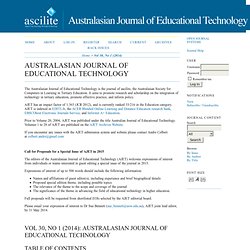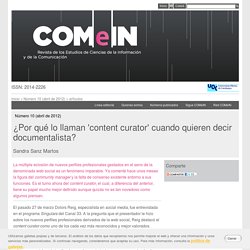

Study_Guide_CDT1. A1-3: Listing of OEPs on wikis. Masterman, L., & Wild, J. (2011). OER Impact Study Research Report. Retrievable from. Sources of Knowledge. Academic journals - Open University of Catalonia (UOC) Journal of Computer-Mediated Communication. Australasian Journal of Educational Technology. The Australasian Journal of Educational Technology is the journal of ascilite, the Australasian Society for Computers in Learning in Tertiary Education.

It aims to promote research and scholarship on the integration of technology in tertiary education, promote effective practice, and inform policy. AJET has an impact factor of 1.363 (JCR 2012), and is currently ranked 33/216 in the Education category. AJET is indexed in EDITLib, the ACER Blended Online Learning and Distance Education research bank, EBSCOhost Electronic Journals Service, and Informit A+ Education. Prior to Volume 20, 2004, AJET was published under the title Australian Journal of Educational Technology. Volumes 1 to 28 of AJET are published on the AJET Archives Website. If you encounter any issues with the AJET submission system and website please contact Andre Colbert at colbert.andre@gmail.com. Wikis in Plain English. A1-2: Debate Summary. Argumentative Text Writing. ( synthesizing ) BloomsTaxonomy. A1-1: Debate.
Open Educational Resources: New Possibilities for Change and Sustainability. Mapa mundial de REA ¿Cómo y por qué? Mapping the landscape of Open Educational Resources institutional initiatives. Over the past decade, there have been more and more initiatives in more and more countries.

It has become difficult to have a sense of the OER landscape. As we seek to explain Open Educational Resources to stakeholders, as we seek to connect with others and as we seek to learn from the experience of others, we might find useful a picture of the OER world – a global map of institutional (and perhaps national) initiatives as a starting point. Over time, an “OER World Map” could be enhanced as the community wished and found feasible. Maps can be effective in immediately communicating a message. There are already several global maps that have been created for specific OER groups, such as, the Open CourseWare Consortium and the UK Open University OLnet project Evidence Hub.
The former IIEP OER community showed enormous energy in its interaction. Can the global OER community design and build an “OER World Map” together? An international discussion12-30 November 2012. Proyecto Oportunidad. Richard Baraniuk on open-source learning. Toutes les tailles. For example. OER creator-user feedback. How to create a slideshare show. Sharing and reuse in OER: experiences gained from open reusable learning objects in health. Sharing and reuse in OER: experiences gained from open reusable learning objects in health.

Richard J Windle, Heather Wharrad, Damion McCormick, Helen Laverty and Michael Taylor School of Nursing, Midwifery and Physiotherapy. The University of Nottingham Queens Medical Centre Nottingham, UK. NG7 2UH www.sonet.nottingham.ac.uk Abstract: The open educational resource (OER) movement has the potential to have a truly transformative effect on higher education, but in order to do so it must move into the mainstream and facilitate widespread participation in the sharing or creating of resources and in their reuse.
Keywords: Open Educational Resources, Reusable Learning Objects, Reuse, Sharing, Community of Practice, Evaluation, Health. 1 Introduction The open educational resources (OER) movement is one of the most exciting developments to emerge within Higher Education for a generation. 2 Methodology 2.1 Resource design Figure 1: Example pages from typical SONET RLOs 2.2 Development Process. Digital Natives, Digital Immigrants. Digital Natives, Digital Immigrants. Diversity. Cultural Values Framework (2) Cultural Values Framework (1) Countries. Please select a country in the dropdown menu above to see the values for the 6 dimensions.

After a first country has been selected, a second and even a third country can be chosen to be able to see a comparison of their scores. To compare your personal preferences to the scores of a country of your choice, please purchase our cultural survey tool, the Culture Compass™. Please note that culture is defined as the collective mental programming of the human mind which distinguishes one group of people from another. This programming influences patterns of thinking which are reflected in the meaning people attach to various aspects of life and which become crystallised in the institutions of a society.
This does not imply that everyone in a given society is programmed in the same way; there are considerable differences between individuals. Digital gap. Digital Aristotle: Thoughts on the Future of Education. Content Curator & roles. ¿Por qué lo llaman 'content curator' cuando quieren decir documentalista? El pasado 27 de marzo Dolors Reig, especialista en social media, fue entrevistada en el programa Singulars del Canal 33.

A la pregunta que el presentador le hizo sobre los nuevos perfiles profesionales derivados de la web social, Reig destacó el content curator como uno de los cada vez más reconocidos y mejor valorados. Según definición de la propia Reig, el content curator, también conocido como curador de contenidos o intermediario de conocimiento, “es un profesional, interno o externo, especialmente implicado con el conocimiento, y que asesorará sobre la información más relevante en el sector”. Podríamos decir que un content curator, es un “intermediario crítico del conocimiento”; es alguien que busca, agrupa y comparte de forma continua lo más relevante en su ámbito de especialización. Su objetivo fundamental es mantener la relevancia de la información que fluye libre o apoyada en herramientas concretas para la creación de entornos informacionales.